Abstract: This application note highlights the initialization and programming of Dallas Semiconductor Framers.
Table 1. Registers with Special Test Modes and Features
Depending on the interrupt structure implemented, it may be a good idea to clear IMR1 and IMR2 first. Prior to clearing these two registers, spurious interrupt signals may occur without an external interrupt disable.
Once the registers have been initialized and set up with the transceiver's mode of operation, the line interface reset bit should be set high, then low. If the elastic store is enabled, the ESR bit should be set, then cleared.
Note 2: If the TEST pin is high, registers can be written to (initialized), but not read.
Note 2: If the TEST pin is high, registers can be written to (initialized), but not read.
Note 2: If the TEST pin is high, registers can be written to (initialized), but not read.
Note 2: If the TEST pin is high, registers can be written to (initialized), but not read.
Note 2: If the SYSCLK pin is high, registers can be written to (initialized), but not read.
Note 2: If the TEST pin is high, registers can be written to (initialized), but not read.
Note 2: If the SYSCLK pin is high, registers can be written to (initialized), but not read.
Note 2: If the TEST pin is high, registers can be written to (initialized), but not read.
Note 2: If the TEST pin is high, registers can be written to (initialized), but not read.
Note 2: If the TEST pin is high, registers can be written to (initialized), but not read.
Note 2: If the TEST pin is high, registers can be written to (initialized), but not read.
Note 2: If the TEST pin is high, registers can be written to (initialized), but not read.
Introduction
This application note shows how to initialize and program Dallas T1/E1 framers. The DS2155, DS21Q55, and DS2156 do not require any special initialization after power-up, since they automatically initialize themselves by clearing and setting the proper registers.General Initialization
After power-up, when supplies and clocks have stabilized, internal registers must be initialized. Please note the DS2155, DS21Q55, and DS2156 do NOT require any special initialization whatsoever since they automatically initialize upon power-up. It is a good idea to clearµset to 0x00µALL R/W registers. The easiest way to do this is to write 0x00 to address space 0x00-0xFF, regardless of register type. Certain registers have bits that control special test modes and features that can provide confusing indications (Table 1).Table 1. Registers with Special Test Modes and Features
| Part | Name |
| DS2151 | TEST, TCR2, LICR |
| DS2152 | TEST1, TEST2, TCR2, LICR |
| DS21352/552 | TEST1, TEST2, TCR2, LICR |
| DS21Q41/Q42 | TEST, TCR2 |
| DS21FF/FT42 | TEST1, TCR2 |
| DS2153 | TEST1, TEST2, LICR |
| DS2154 | TEST1, TEST2, LICR |
| DS21354/554 | TEST1, TEST2, TCR2, LICR |
| DS21Q43/Q44 | TEST1, TEST2 |
| DS21FF/FT44 | TEST1, TEST2 |
Depending on the interrupt structure implemented, it may be a good idea to clear IMR1 and IMR2 first. Prior to clearing these two registers, spurious interrupt signals may occur without an external interrupt disable.
Once the registers have been initialized and set up with the transceiver's mode of operation, the line interface reset bit should be set high, then low. If the elastic store is enabled, the ESR bit should be set, then cleared.
Special Initialization for DS2141
Transmit clock (TCLK) must be present for proper port initialization. Network signals (loop timing) cannot be guaranteed to replace a missing TCLK during initialization. The following sequence should be used to initialize the DS2141, in which TCLK is not present or TCLK is derived from RCLK (a loop-timed system).- Write 0x00 to all other R/W registers
- Write initial device configuration data
- Wait for SYSCLK to stabilize if elastic stores enabled
Special Initialization for DS21Q41
Transmit clock (TCLK) must be present for proper port initialization. This clock can be sourced externally from the TCLK pin or internally from RCLK through the loss-of-transmit clock mux. This mux is enabled by setting TCR1.7. The following sequence should be used to initialize the DS21Q41, in which TCLK is not present or TCLK is derived from RCLK (a loop-timed system).- Set LOTCMC bit in TCR1 register
- Wait 10ms minimum
- Write 0x00 to all other R/W registers
- Write initial device configuration data
- Wait for TSYSCLK and RSYSCLK to stabilize if elastic stores enabled
- Set ESR bit in CCR3 register if elastic stores enabled
- Clear ESR bit
Note 2: If the TEST pin is high, registers can be written to (initialized), but not read.
Special Initialization for DS21Q42
Transmit clock (TCLK) must be present for proper port initialization. This clock can be sourced externally from the TCLK pin or internally from RCLK through the loss-of-transmit clock mux. This mux is enabled by setting TCR1.7. The following sequence should be used to initialize the DS21Q42, in which TCLK is not present or TCLK is derived from RCLK (a loop-timed system).- Set LOTCMC bit in TCR1 register
- Wait 10ms minimum
- Write 0x00 to all other R/W registers
- Write initial device configuration data
- Wait for TSYSCLK and RSYSCLK to stabilize if elastic stores enabled
- Set TESR and RESR bits in CCR7 register if elastic stores enabled
- Clear TESR and RESR bits
Note 2: If the TEST pin is high, registers can be written to (initialized), but not read.
Special Initialization for DS2143
Transmit clock (TCLK) must be present for proper port initialization. Network signals (loop timing) cannot be guaranteed to replace a missing TCLK during initialization. The following sequence should be used to initialize the DS2143, in which TCLK is not present or TCLK is derived from RCLK (a loop-timed system).- Write 0x00 to all other R/W registers
- Write initial device configuration data
- Wait for SYSCLK to stabilize if elastic stores enabled
Special Initialization for DS21Q43
Transmit Clock (TCLK) must be present for proper port initialization. This clock can be sourced externally from the TCLK pin or internally from RCLK via the LOSS of TRANSMIT CLOCK mux. This mux is enabled by setting CCR2.2. The following sequence should be used to initialize the DS21Q43 in which TCLK is not present or TCLK is derived from RCLK (a loop timed system).- Set LOTCMC bit in CCR2 register
- Wait 10ms minimum
- Write 0x00 to all other R/W registers
- Write initial device configuration data
- Wait for TSYSCLK and RSYSCLK to stabilize (if elastic store(s) enabled)
- Set ESR bit in CCR3 register (if elastic store(s) enabled)
- Clear ESR bit
Note 2: If the TEST pin is high, registers can be written to (initialized), but not read.
Special Initialization for DS21Q44
Transmit clock (TCLK) must be present for proper port initialization. This clock can be sourced externally from the TCLK pin or internally from RCLK through the loss-of-transmit clock mux. This mux is enabled by setting CCR2.2. The following sequence should be used to initialize the DS21Q44, in which TCLK is not present or TCLK is derived from RCLK (a loop-timed system).- Set LOTCMC bit in CCR2 register
- Wait 10ms minimum
- Write 0x00 to all other R/W registers
- Write initial device configuration data
- Wait for TSYSCLK and RSYSCLK to stabilize (if elastic store(s) enabled)
- Set TESR and RESR bits in CCR6 register (if elastic store(s) enabled)
- Clear TESR and RESR bits
Note 2: If the TEST pin is high, registers can be written to (initialized), but not read.
Special Initialization for DS2151
Transmit clock (TCLK) must be present for proper port initialization. This clock can be sourced externally from the TCLK pin or internally from RCLK through the loss-of-transmit clock mux. This mux is enabled by setting TCR1.7. The following sequence should be used to initialize the DS2151, in which TCLK is not present or TCLK is derived from RCLK (a loop-timed system).- Set LOTCMC bit in TCR1 register
- Wait 10ms minimum
- Write 0x00 to all other R/W registers
- Write initial device configuration data
- SET LIRST bit in CCR3 register
- Wait for SYSCLK to stabilize if elastic stores enabled
- Set ESR bit in CCR3 register if elastic stores enabled
- Clear LIRST and ESR bits
Note 2: If the SYSCLK pin is high, registers can be written to (initialized), but not read.
Special Initialization for DS2152
Transmit clock (TCLK) must be present for proper port initialization. This clock can be sourced externally from the TCLK pin or internally from RCLK through the loss-of-transmit clock mux. This mux is enabled by setting TCR1.7. The following sequence should be used to initialize the DS2152, in which TCLK is not present or TCLK is derived from RCLK (a loop-timed system).- Set LOTCMC bit in TCR1 register
- Wait 10ms minimum
- Write 0x00 to all other R/W registers
- Write initial device configuration data
- Set LIRST bit in CCR7 register
- Wait for TSYSCLK and RSYSCLK to stabilize if elastic stores enabled
- Set ESR bit in CCR3 register if elastic stores enabled
- Clear LIRST and ESR bits
Note 2: If the TEST pin is high, registers can be written to (initialized), but not read.
Special Initialization for DS2153
Transmit clock (TCLK) must be present for proper port initialization. This clock can be sourced externally from the TCLK pin or internally from RCLK through the loss-of-transmit clock mux. This mux is enabled by setting CCR2.2. The following sequence should be used to initialize the DS2153, in which TCLK is not present or TCLK is derived from RCLK (a loop-timed system).- Set LOTCMC bit in CCR2 register
- Wait 10ms minimum
- Write 0x00 to all other R/W registers
- Write initial device configuration data
- Set LIRST bit in CCR3 register
- Wait for SYSCLK to stabilize (if elastic store(s) enabled)
- Set ESR bit in CCR3 register (if elastic store(s) enabled)
- Clear LIRST and ESR bits
Note 2: If the SYSCLK pin is high, registers can be written to (initialized), but not read.
Special Initialization for DS2154
Transmit clock (TCLK) must be present for proper port initialization. This clock can be sourced externally from the TCLK pin or internally from RCLK through the loss-of-transmit clock mux. This mux is enabled by setting CCR2.2. The following sequence should be used to initialize the DS2154, in which TCLK is not present or TCLK is derived from RCLK (a loop-timed system).- Set LOTCMC bit in CCR2 register
- Wait 10ms minimum
- Write 0x00 to all other R/W registers
- Write initial device configuration data
- Set LIRST bit in CCR5 register
- Wait for TSYSCLK and RSYSCLK to stabilize (if elastic store(s) enabled)
- Set ESR bit in CCR3 register (if elastic store(s) enabled)
- Clear LIRST and ESR bits
Note 2: If the TEST pin is high, registers can be written to (initialized), but not read.
Special Initialization for DS21FF/FT42
Transmit clock (TCLK) must be present for proper port initialization. This clock can be sourced externally from the TCLK pin or internally from RCLK through the loss-of-transmit clock mux. This mux is enabled by setting TCR1.7. The following sequence should be used to initialize the DS21FF/FT42, in which TCLK is not present or TCLK is derived from RCLK (a loop-timed system).- Set LOTCMC bit in TCR1 register
- Wait 10ms minimum
- Write 0x00 to all other R/W registers
- Write initial device configuration data
- Wait for SYSCLK to stabilize if elastic stores enabled
- Set TESR and RESR bits in CCR7 register if elastic stores enabled
- Clear TESR and RESR bits
Note 2: If the TEST pin is high, registers can be written to (initialized), but not read.
Special Initialization for DS21FF/FT44
Transmit Clock (TCLK) must be present for proper port initialization. This clock can be sourced externally from the TCLK pin or internally from RCLK through the loss-of-transmit clock mux. This mux is enabled by setting CCR2.2. The following sequence should be used to initialize the DS21FF/FT44, in which TCLK is not present or TCLK is derived from RCLK (a loop-timed system).- Set LOTCMC bit in CCR2 register
- Wait 10ms minimum
- Write 0x00 to all other R/W registers
- Write initial device configuration data
- Wait for SYSCLK to stabilize if elastic stores enabled
- Set TESR and RESR bits in CCR6 register if elastic stores enabled
- Clear TESR and RESR bits
Note 2: If the TEST pin is high, registers can be written to (initialized), but not read.
Special Initialization for DS21x52
Transmit clock (TCLK) must be present for proper port initialization. This clock can be sourced externally from the TCLK pin or internally from RCLK through the loss-of-transmit clock mux. This mux is enabled by setting TCR1.7. The following sequence should be used to initialize the DS21x52, in which TCLK is not present or TCLK is derived from RCLK (a loop-timed system).- Set LOTCMC bit in TCR1 register
- Wait 10ms minimum
- Write 0x00 to all other R/W registers
- Write initial device configuration data
- Set LIRST bit in CCR7 register
- Wait for TSYSCLK and RSYSCLK to stabilize if elastic stores enabled
- Set TESR and RESR bits in CCR7 register high if elastic stores enabled
- Clear LIRST, TESR, and RESR bits
Note 2: If the TEST pin is high, registers can be written to (initialized), but not read.
Special Initialization for DS21x54
Transmit Clock (TCLK) must be present for proper port initialization. This clock can be sourced externally from the TCLK pin or internally from RCLK through the loss-of-transmit clock mux. This mux is enabled by setting CCR2.2. The following sequence should be used to initialize the DS21x54, in which TCLK is not present or TCLK is derived from RCLK (a loop-timed system).- Set LOTCMC bit in CCR2 register
- Wait 10ms minimum
- Write 0x00 to all other R/W registers
- Write initial device configuration data
- Set LIRST bit in CCR5 register
- Wait for TSYSCLK and RSYSCLK to stabilize if elastic stores enabled
- Set TESR and RESR bits in CCR6 register high if elastic stores enabled
- Clear LIRST, TESR, and RESR bits
Note 2: If the TEST pin is high, registers can be written to (initialized), but not read.
 电子发烧友App
电子发烧友App










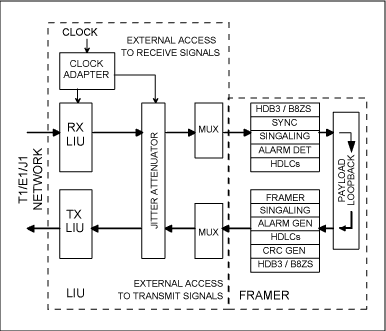
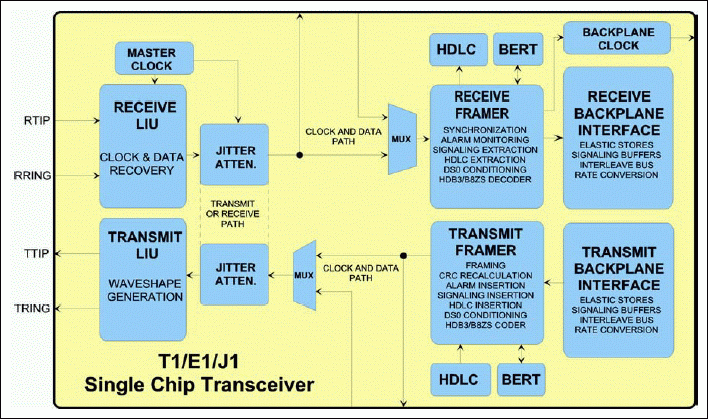
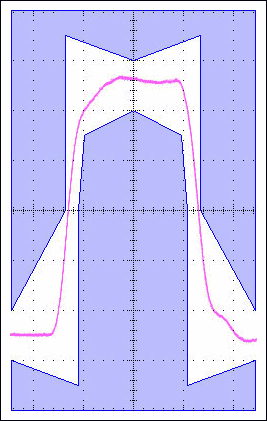
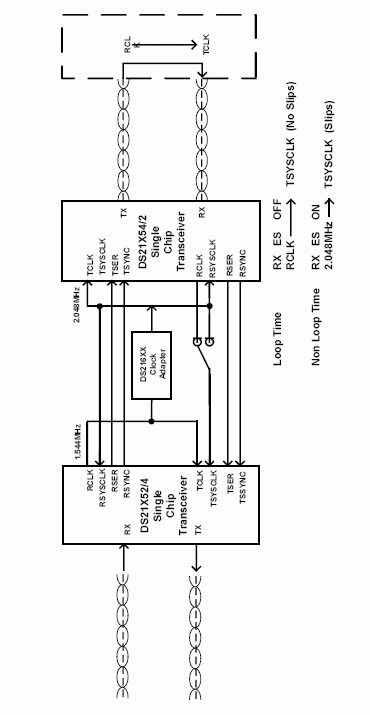
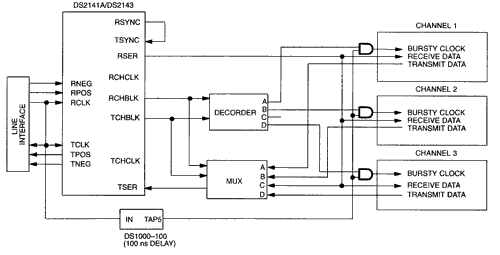

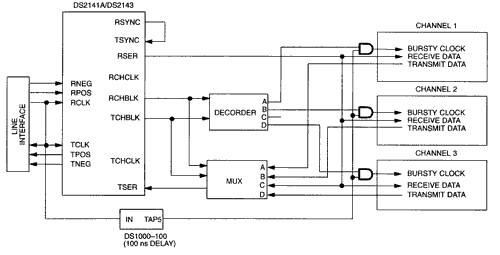


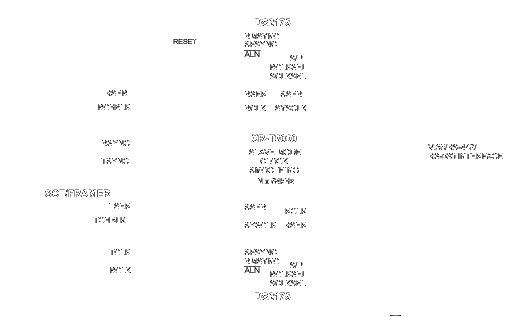










评论